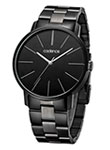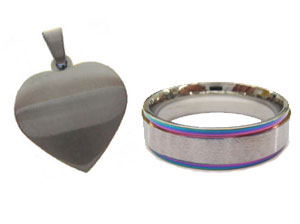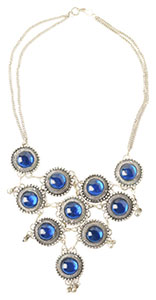 Now might be the perfect time to get into the watch and jewelry business, or expand into new product lines. Experts in the fashion jewelry and watch market say the improving economy has been good for business in almost every sector of the market.
Now might be the perfect time to get into the watch and jewelry business, or expand into new product lines. Experts in the fashion jewelry and watch market say the improving economy has been good for business in almost every sector of the market.
“The jewelry sector was very stagnant for a while,” says Adri Sfalcin, executive director of the Mid America Jewelers Association, with headquarters in Ohio. “People seem to think the economy is turning around.” But like so many other market segments, the jewelry and watch market emerges from the recession as a very changed business, with both new opportunities and new challenges for retailers.
Mom-and-pop versus online retailers: no competition
Even before the recession, there was little question the jewelry business was seeing heavy inroads from online retailers. Today, the online segment is a thriving business for many independent retailers, and only promising to grow. Companies like Cadence Watch Company design their own watches and deal directly with overseas factories, making it possible to offer much lower prices directly to consumers, explains Vanya Buvach, CEO of Cadence. Other companies like Lee Mode are watching online sales steadily grow as a proportion of overall sales. Lee Mode HR Manager, Sung Ha, says that, “Retailers should be looking into or already using websites.”
 Part of the shift, Sfalcin notes, is generational. “A lot of kids are buying diamonds online.” Because of this growth in online sales, independent retailers should be paying close attention to issues like the Internet sales tax, which would have the potential to decrease online sales. Still, even with the growth in web sales, there is still plenty of opportunity for retailers who sell in brick-and-mortar shops, or at shows and swap meets. “We’ve seen a great increase in the overall outlook of the economy,” says Brian Nelson, sales manager with Sun Fashion Designs. For Sun Fashion, this has translated into increased sales of ring and pendant stamping machines that allow retailers to offer a line of customized jewelry. “The custom items are huge,” he explains. “Not only are our retail customers excited because of the huge markup and ability to create another business, but the end consumers are excited.”
Part of the shift, Sfalcin notes, is generational. “A lot of kids are buying diamonds online.” Because of this growth in online sales, independent retailers should be paying close attention to issues like the Internet sales tax, which would have the potential to decrease online sales. Still, even with the growth in web sales, there is still plenty of opportunity for retailers who sell in brick-and-mortar shops, or at shows and swap meets. “We’ve seen a great increase in the overall outlook of the economy,” says Brian Nelson, sales manager with Sun Fashion Designs. For Sun Fashion, this has translated into increased sales of ring and pendant stamping machines that allow retailers to offer a line of customized jewelry. “The custom items are huge,” he explains. “Not only are our retail customers excited because of the huge markup and ability to create another business, but the end consumers are excited.”
Overall, says Sfalcin, the key to growing a successful jewelry business is finding out what your customers want, and delivering the right products at the right price point. “I still believe the mom ‘n pop jewelry store will survive,” she states. “The chain stores and bridal shops are always going to do well, but we’re seeing a lot more of the independent stores creating and designing their own jewelry.”
On trend: customization and silver
In fact, customization is red-hot in every part of the jewelry market. Increasingly sophisticated technology has made it possible for companies like Sun Fashion to offer its stamping machine for less than $800, while Lee Mode is reporting strong sales of “statement necklaces,” which are known for their varied and unique designs. “For example, we’re selling a lot of white camouflage rings that are stamped with pink,” says Nelson. “The girls turned out to want pink stamping. There is a crazy variety of combinations you can make.”
 In addition to customizable jewelry, retailers and wholesalers are reporting increased interest in silver, silver finishes, and semi-precious stones. At least part of this is likely driven by the high cost of gold. As of early May, gold was trading near historical highs of $1,300/ounce. This price inflation has affected demand at the mid and lower ranges of the jewelry market by steering consumers away from gold toward more economical options. “Silver is so prominent right now because the price of gold is so high,” Sfalcin points out.
In addition to customizable jewelry, retailers and wholesalers are reporting increased interest in silver, silver finishes, and semi-precious stones. At least part of this is likely driven by the high cost of gold. As of early May, gold was trading near historical highs of $1,300/ounce. This price inflation has affected demand at the mid and lower ranges of the jewelry market by steering consumers away from gold toward more economical options. “Silver is so prominent right now because the price of gold is so high,” Sfalcin points out.
In the watch market, Buvach adds that his most popular watch, the Winston, features a black face with a black link band. “The ionic plated black designs with stainless steel link bracelets are doing very well,” he says. “We have a hard time keeping these in stock.”
Gold watches are the next most popular. The watch market, in fact, has been driven by a strong interest by younger buyers; the same buyers who likely carry around smart phones with built-in digital clocks all day. “We cater to younger customers around 18 to 25, who don’t see watches as time keepers,” Buvach notes. “For them it’s pure fashion, which means they’re more likely to buy a few of them.” Among this group, larger faces (up to 45 mm) tend to be more popular, and watch manufacturers are preparing to release new timing mechanisms that mimic the uninterrupted sweeping second hand of older watches. “It’s true that young kids rely really heavily on cell phones,” Sfalcin notes. “But you see a lot of young kids with watches on. With the economy coming back, they’re buying watches again, so I think independent retailers who don’t have a watch line should bring one in.”
Overall, the most popular types of jewelry items, familiar to many retailers, include rings, earrings, and stackable bracelets. However, the watch and jewelry market also continues to benefit from unconventional business opportunities and new products. For example, mirrored jewelry cases that hang from the wall and double as mirrors are selling strongly, says Sflacin, while Buvach at Cadence is seeing the rise of new business models such as short-term rental services for high-end watches.
In the fine jewelry market, the “checkboard cut” has become increasingly popular, and people look for fresh designs. “I think there’s a lot of opportunity right now for independent retailers,” Sflacin declares. “If someone goes to a chain, they’re going to see the same thing at every place. But when you go to an independent retailer, everybody has something a little different.”
Mid America Jewelers Association
Tel.: 800-652-6257
Website: www.midamericajewelers.org
Sun Fashion Designs
Tel.: 928-778-9585
Website: www.sunfashionjewelry.com
Lee Mode
Tel.: 201-336-9666
Website: www.leemode.com